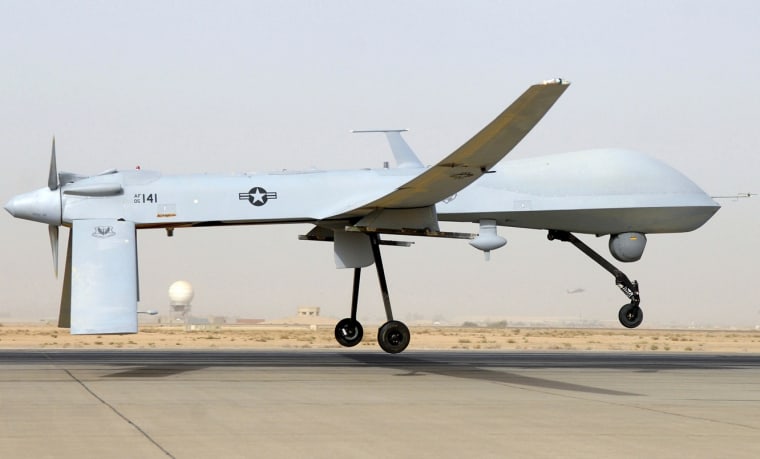I say drone, you say drone. "Drone" has come to mean any aerial vehicle that flies without a person actually sitting in it.
But there are different types of unmanned flying machines, and no one can quite agree which are drones and which aren't. Some say drones are dumb, like the radio-controlled planes used for target practice in World War II; others say drones have to be smart, capable of operating without a human for brief spells.
"We have a perfectly good definition," said Les Dorr, a spokesperson for the Federal Aviation Administration: "unmanned aircraft system" or UAS. The FAA uses the designation to describe anything from a remote-controlled model helicopter to a passenger plane-size Predator attack craft seen flying over Afghanistan.
The Department of Defense applies the term to "an aircraft or balloon" that can be controlled by a person from afar or programmed for autonomous flight.
"Drone" has a negative connotation among military and professional users as a dumb craft, not something autonomously smart or guided by an operator using sophisticated gear.
The original drones were "slow, low-flying targets that you hit," said Missy Cummings, an ex-fighter pilot for the Navy, who now directs a lab at MIT that researches autonomous and "supervised" flying systems.
In 1917, Charles Kettering invented the Kettering Bug in Dayton, Ohio. Conceived as a flying torpedo, versions of it were tested but never used by the military. During World War II, the actor and former RAF pilot Reginald Denny founded a company that manufactured "target drone Dennys," among the first radio-controlled aircrafts.
So who does call them drones? Besides the media and politicians, that is?
Chris Anderson does. The former Wired editor, who now runs 3Drobotics and diydrones.com, says "drones" include all manners of remotely controlled flying objects, large and small, with one caveat: They must be capable of switching to autonomous flight of some description, at least part of the time. So those basic remote-controlled aircraft you can build yourself? Those aren't drones, he told NBC News.
Ryan Calo, a professor of law at the University of Washington, also calls them drones. To him, a drone needs to have three qualities: First, it needs to be able to fly. Then, it needs to have some sensing capacity: a camera or an infrared sensor, or similar. And finally, Calo's drones are capable of some level of autonomy, perhaps following GPS coordinates or a moving guide.
Though Anderson and Calo argue that "drone" implies autonomy, while military and professional groups say the opposite, the contradiction doesn't bother Calo. "I don’t think at the end of the day we need to all agree on a term," he tells NBC News, "Language is dynamic."
Besides, it's easier and more fun to say "drone" than "unmanned aircraft system." But if you want to avoid confusion (or just impress your friends), here are a variety of unmanned aircraft systems that have cropped up throughout history:
Flying torpedoes and target drones
The Kettering Bug is among the earliest unmanned aircraft. First tested as an unmanned aerial torpedo in 1917, the Bug rolled off an aircraft, then its "electrical and pneumatic controls" guided it toward a target. Along the way its engine shut down, its wings fell off and it fell out of the sky onto its target. The Bug was never put to use by the military, but by World War II, target drones such as the Denny were in demand.
Remote-controlled aircraft
The hobbyist descendants of the WWII target drones, small aircrafts like this one can run on gas or electricity and are radio-controlled. They can be gliders or carry a propeller. They may carry cameras on board by typically lack any kind of autopilot setting. If communications cut out, unless they're catching a good gust of wind, they will fall from the sky.
Semi-autonomous RC aircraft
The AR Drone 2.0 hobbyist flyer can fit under your bed. It has a built-in HD camera that streams a live-feed view of what the Parrot is watching onto your smartphone. It has a USB drive and connects to Wi-Fi. They're not autonomous "out of the box," Calo says, but because they can be programmed, they count in his book.
Aerial robots
AeroVironment's Qube is an example of the type of aerial robots used in both military and non-military applications. It can monitor wildlife and give scientists a peek into volcanoes. It has high-resolution and thermal cameras on board, and can be programmed for autonomous bursts of flight, while being controlled from afar. Though it's usually used as as first-responder rather than a snooper, its communications channel can be encrypted.

Unmanned military aircraft
Aircraft like this Predator UAS have a wingspan of 55 feet, substantially greater than a Cessna 172 or other small manned aircraft. The first Predators were used in 1994, and today they come armed with Hellfire missiles. According General Atomics Aeronautical, which makes them, the Predator UAS was the first weaponized autonomous system the military ever used. Today's predators can can stay in the air for 40 hours and fly at 25,000 feet, managed from afar via satellite.
Nidhi Subbaraman writes about technology and science. Follow heron Twitter andGoogle+.